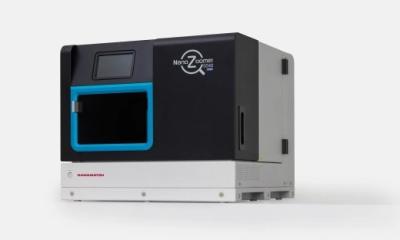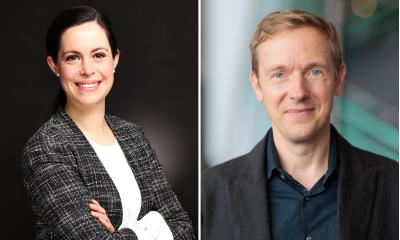Article • Future changes
Laboratory medicine is an interdisciplinary subject
‘Lab medicine connects’ is the congress theme of the German Congress of Laboratory Medicine and reflects the fact that laboratory medicine is an interdisciplinary subject like no other and connects those who are involved in medicine across disciplines. It works almost imperceptibly in the background, hardly noticed by patients. European Hospital spoke with this year’s Congress President, Professor Berend Isermann, from University Hospital Magdeburg, about the challenges the discipline faces.

Liquid biopsy or liquid profiling: will pathologists invade lab turf?
‘Indeed, liquid biopsy and liquid profiling are different terms for the same procedure, which originates in oncology. Cell-free DNA or RNA, meaning cell-free nucleic acid, in blood allows the evaluation of tumour development. Tumour growth and tumour decrease can be shown quantitatively and new mutations can be detected.
‘Laboratory medicine can use this procedure to detect many more changes, mostly epigenetic ones, such as damages to the beta cells at the onset of type 1 diabetes, or cell failure with type 2 diabetes. The potential is much wider and not at all limited to oncology. This is why we clearly prefer the term “liquid profiling”. The term “liquid biopsy” misleadingly suggests that the technique is similar to tissue biopsy and thus an element of pathology. What it really is, is liquid profiling – a procedure lab medicine has known and been doing for decades with the only difference being the fact that before we used blood proteins to establish a profile of a disease or a tumour. Cell-free nucleic acid is just another parameter.
‘We are convinced that surveillance analysis is our job. There is a long-standing division of labour, which makes sense. This does not cut into the tasks of pathologists, quite the contrary: the two will complement each other very well. Histology will always be the first step: evaluating the lesion in situ and establishing the grade. This cannot be done using cell-free RNA/DNA – it will remain the pathologist’s domain.
‘Furthermore, the search for mutations in tissue will continue to be necessary as they are important tumour markers. However, generally speaking, a technology such as molecular diagnostic testing ought not be limited to a single group. We are not doing that and we expect others not to do that either.’
POCT developments
‘Point-of-care testing is becoming ever smaller and more compact. The current trend is called microfluidics, which means less volume and fewer reagents are required bedside to achieve accurate results. However, it is important to carefully evaluate where POCT is necessary, as it is still an expensive procedure and less reliable than lab procedures in terms of specificity and sensitivity.
Obviously, there are situations and locations where POCT is indicated, be that emergency medicine or a remote doctor’s office in the countryside. For the industry, POCT is a major growth segment. In view of these considerations, we expect POCT to be a controversial issue at the congress.’
Assuring POCT quality
‘No doubt, POCT is real technological progress and will become better and better. At the same time, correct pre-analytics has to be guaranteed – which is problematic because basically everybody works with the devices. Moreover, the quality of the results may well turn out to be a problem, since the people using the devices are not necessarily those who maintain them and ensure compliance with the law.
‘Another issue is data management. It does not suffice to print the findings in a report and file it in the patient record. The data and results must be entered in the information system. At my institution, University Hospital Magdeburg, we have a POCT system and a working group that takes care of all issues and aspects involved in this technology. To support e-health, data that were generated at any location have to be input in the information system to make them available for everyone who needs them.
‘In my opinion it’s clearly the task of the labs to ensure quality along the entire chain from pre-analytics through analytics down to post-analytics. In healthcare we have long been pioneers in terms of quality assurance und quality management – and we want to keep it that way.’
It’s very important for us to stay in touch with our medical colleagues, because this is the only way to ensure we have an uninterrupted flow of information
Professor Berend Isermann
Lab medicine challenges and major future changes
‘That’s a very complex question. One of our main concerns is – as in many other disciplines – to attract talent. We started a number of initiatives to promote junior professionals from graduate level programs to funding a chair. We offer train-the-trainer courses and established a junior academy together with the German Research Foundation. We put a lot of effort in these programmes and they do bear fruit: we could generate interest and the programmes are well accepted.
‘Going forward rather than simply generating data, we have to focus on analysing and managing complex data sets to be able to cull more relevant information from these data. Systems diagnostics is a major change on the horizon and it’s an issue in our junior academy. There will be more bio-informaticians in the labs – a development we welcome because the natural scientists in our discipline have always been very innovative.’
New analytical methods
‘There will be new analytical methods such as proteomics. High-resolution protein analysis has not yet arrived in lab routine, but it will do so because it yields a lot more information. It not only shows that something is docking onto the antibody but also shows the protein fragment itself – its modifications and much more. It creates information on an entirely new level.’
Cooperation with medical colleagues and patients
‘It’s very important for us to stay in touch with our medical colleagues, because this is the only way to ensure we have an uninterrupted flow of information. In the future, we will be playing an increasingly important role as consultants. The added value we create in medicine is often under-appreciated. We are sitting in the backseat, without direct contact with patients. Nevertheless, 70 percent of all diagnoses can be correctly made based on lab results. This is an extremely high level of performance – at a mere three percent of healthcare spend.
‘Diagnostic imaging is much more time consuming and expensive than lab diagnostics. Lab medicine has become so efficient and so quiet that it’s now not noticed and taken for granted. Our contribution to the diagnostic process should not be underestimated and maybe even be more appreciated. Laboratory medicine connects! In the future we will be open to organise our congress jointly with other disciplines.’
Profile:
After receiving his doctoral degree at the University of Würzburg, Germany, Professor Berend Isermann was Research Fellow at the Blood Research Institute in Milwaukee, Wisconsin, USA. Subsequently, he then joined the Department of Internal Medicine at the University of Heidelberg where in 2008 he obtained his qualification for university professorship. One year later he was appointed Director of Clinical Chemistry at the institution’s Department of Internal Medicine. Since 2011 he has been heading the Institute of Clinical Chemistry and Pathobiochemistry at Otto von Guericke University, Magdeburg, Germany. Professor Isermann focuses his research on coagulation proteases, chronic vascular diseases, diabetic nephropathy and sterile inflammation.
16.09.2016











